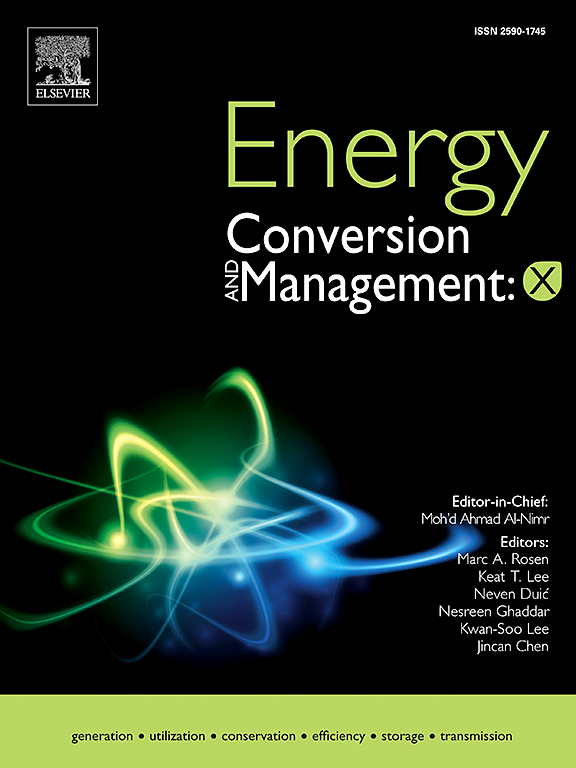考虑可再生能源生产预测的不确定性与优化混合电站的相关性:一个强大的MILP方法
IF 10.9
1区 工程技术
Q1 ENERGY & FUELS
引用次数: 0
摘要
混合电站(HPS)将可再生能源与存储系统相结合,通过将间歇性生产转化为可调度的电力,为提高可再生能源(RES)的渗透率提供了一个很有前途的解决方案。本研究强调了考虑电力生产预测中的不确定性对改善这些系统管理的重要性,并提出了一个混合整数线性规划(MILP)框架,能够考虑多种可能的结果,而不是单一的结果。使用一年的历史预测和实际生产数据集,该研究开发并测试了三种调度策略:基于规则的、使用原始预测的标准MILP和稳健的MILP。后者考虑了几种生产场景,以提高调度计划的可靠性,这对具有严格操作约束的电网很有价值。与以往的文献研究不同,本工作深入研究了预测情景生成跨度的调整和鲁棒优化约束的放松。敏感性分析表明,风能和太阳能的预测情景范围分别为±20%和±30%,加上12欧元/兆瓦时的适度偏差惩罚,在系统可靠性和经济性能之间提供了最佳平衡。基于规则的策略输出235.9兆瓦时/年,但遭受高不足,净收益减少16.3%。标准的MILP方法提高了性能,增加了年度能源出口,减少了不足,与基于规则的策略的19.7.5万欧元/年相比,每年的净收益为213.2万欧元。强大的MILP方法进一步优化了性能,实现了21.8兆瓦时/年的低冲,净收益为223万欧元/年(仅比总收入减少3.1%),表明该策略可以提高HPS运行的可靠性,同时减少与预测错误相关的惩罚。本文章由计算机程序翻译,如有差异,请以英文原文为准。

On the relevance of considering the uncertainty in renewables production forecasts to optimize hybrid power stations: a robust MILP approach
Hybrid Power Stations (HPS), integrating RES with storage systems, offer a promising solution to increase the penetration of renewable energy sources (RES) by converting intermittent production into dispatchable power. This study underlines the importance of considering the uncertainty in forecasts of power production to improve the management of these systems and proposes a Mixed-Integer Linear Programming (MILP) framework able to account for multiple possible outcomes, instead of a single one. Using a one-year dataset of historical forecasts and actual production, the study develops and tests three dispatch strategies: rule-based, standard MILP using raw forecasts, and robust MILP. The latter considers several production scenarios to enhance the reliability of the dispatch plan, valuable for grids with strict operational constraints. Unlike previous studies in the literature, this work dives into the aspect of tuning the span in which prediction scenarios are generated and the relaxation of constraints of the robust optimization. Sensitivity analyses showed that a forecast scenario span of ± 20 % for wind and ± 30 % for solar, paired with a moderate divergence penalty of €12/MWh, offered the best balance between system reliability and economic performance. The rule-based strategy exported 235.9 MWh/year but suffered from high undershooting, reducing net earnings by 16.3 %. The standard MILP approach improved performance, increasing annual energy exports and reducing undershooting, resulting in net earnings of €213.2 k/year compared to €197.5 k/year for the rule-based strategy. The robust MILP approach further optimized performance, achieving only 21.8 MWh/year of undershooting and net earnings of €223 k/year (only 3.1 % reduction from gross earnings), demonstrating that this strategy can improve the reliability of HPS operation while reducing penalties associated with forecast errors.
求助全文
通过发布文献求助,成功后即可免费获取论文全文。
去求助
来源期刊

Energy Conversion and Management
工程技术-力学
CiteScore
19.00
自引率
11.50%
发文量
1304
审稿时长
17 days
期刊介绍:
The journal Energy Conversion and Management provides a forum for publishing original contributions and comprehensive technical review articles of interdisciplinary and original research on all important energy topics.
The topics considered include energy generation, utilization, conversion, storage, transmission, conservation, management and sustainability. These topics typically involve various types of energy such as mechanical, thermal, nuclear, chemical, electromagnetic, magnetic and electric. These energy types cover all known energy resources, including renewable resources (e.g., solar, bio, hydro, wind, geothermal and ocean energy), fossil fuels and nuclear resources.
 求助内容:
求助内容: 应助结果提醒方式:
应助结果提醒方式:


